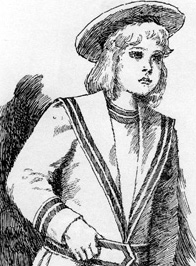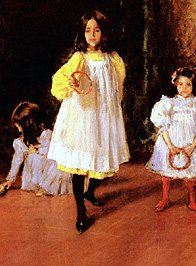Here you can find detailed information on the child clothing word during the late 19th century. For an overview of the clothing worn within the Alienist books, or for detailed information on male and female clothing during the late 19th century, please use the menu.
Child Clothing in the Alienist Books
Infants
Infants of both sexes wore long, dainty gowns with equally long ‘wrappers’ over the top.1 The fashion plate to the right illustrates an infant wrapper from 1893. Booties and fabric bonnets were also worn.2 All clothing articles were white and had decorative lace and frills. In addition, they had elaborate needle-work designs around the collars, cuffs, and hems.1
Small Children
Once a child started to crawl and walk, the long gowns of infancy were replaced with loose white frocks that reached the top of the calf.1 These frocks often had long sleeves and very wide bertha collars made of lace.3 The coats worn over the top of these outfits also reached the top of the calf, were equally loose, and had large collars.1 On the feet, children wore buttoned or laced shoes and boots. Under their shoes, boys wore dark ribbed woolen socks while girls wore plain dark stockings.4
Even though both sexes wore highly similar frocks at this age, those worn by boys did have some differences; they buttoned at the front rather than the back, had less elaborate trimming, and sometimes had a belt placed around the waist.5 Additionally, although sexual “colour coding” (i.e., dressing girls in pink and boys in blue) did not start until the 1920s, dressing boys in darker colours was not uncommon in the 1890s.3,5 Box pleated skirts, or kilts, were also popular choices for boys as an alternative to more feminine skirts.1,3,4 These could be worn with blouses, tunics, and reefer jackets, or as one-piece pleated frocks.1,3,4
Older Boys
In the late 19th century, the age when boys were able to transition out of skirts was changing. Specifically, until the early 1890s, boys were still dressed in skirts until the age of five or six but by the end of the decade, this age had been lowered to two or three years old.5 Regardless of specific age, once a boy was considered old enough to move out of skirts, he began wearing close-fitting knee-length pants known as knickerbockers until the age of twelve.4
Unlike knickerbockers from previous decades which closed under the knee, during this period they hung loose.4 The shirts and jackets worn with these pants often had a military or naval influence; for example, the sailor suit was highly popular and the adult reefer and Norfolk jackets were adapted for boys as well.3,4,5 A knitted jersey could also be worn under these jackets for extra warmth.4 A sailor suit from 1893 can be seen in the fashion plate to the left. When formality was required, it was acceptable to accessorise the knickerbocker suit with a large floppy bow tied with a soft scarf.3 As with younger boys, knee-high ribbed woolen socks in dark colours were worn, along with buttoned or laced shoes and boots.4
Even with the aforementioned options available to them, some mothers still preferred to dress their boys more extravagantly for special occasions. For instance, the Little Lord Fauntleroy suit, inspired by Frances Hodgson Burnett’s 1885/6 book of the same name, was a highly popular outfit that consisted of velvet knickerbockers and a matching jacket.3,4 It was worn with a blouse that was characterised by a lace collar so large that it hung over the shoulders.3,4
To match such outfits, hair could be kept long in ringlets.4 It should be noted, however, that not all mothers wished their sons to look quite so feminine; many photographs from the period show boys, even those wearing the Little Lord Fauntleroy suits, with short hair styles similar to those that were fashionable for adult males.3,5 The undergarments worn by male children were also essentially the same as those worn by their adult counterparts; woolen vests and drawers were the norm.4
Older Girls
Frocks and coats for girls in middle childhood did not change drastically from early childhood; the most significant alteration was the gradual lengthening of the skirt down to the mid-calf.5 Wide lace bertha collars, similar to those from early childhood, could still be worn on the frock although smocking around the chest and cuffs was the more popular form of decoration for this age group.3,4 A cape effect at the shoulders might also be seen. Sleeves followed the adult fashion for increased fullness; some even achieved the volume of leg-of-mutton sleeves although this does not appear to have been common.3 Reflecting the trend in adult female dress toward more masculine styles, young girls could also wear a variant of the boys’ sailor suit. This was worn with a knitted jersey, a tam-o’-shanter, and a pleated skirt instead of pants.4
Dark coloured stockings were worn to accompany these outfits. A low-fronted shoe with a bar or buckle over the instep was introduced in the 1890s for older girls to wear on special occasions. For everyday wear, however, buttoned or laced shoes and boots were still the norm. Undergarments for girls included a chemise, drawers, and a petticoat. Although stays of pique could be worn to support the drawers and stockings, corsets were not worn by children.4
Throughout the decade, it was fashionable for young girls to wear their hair long under a simple Alice band. Curls or ringlets were desired, but for those with straight hair simply brushing it smooth was also acceptable.4 If hair was to be styled, braiding was preferred; adult hair fashions were not considered appropriate for girls under the age of twelve.4,5
Adolescents
From the age of twelve onwards, both boys and girls began wearing adult styles of clothing. For boys, this means that knickerbockers were replaced with long trousers and costume styled outfits were no longer worn. For girls, this means that the corset was introduced, the skirt was lengthened again, and dress styles began to more closely resemble those worn by adults. This change in clothing style for both males and females meant that hair could also be styled in an adult fashion.5
References
1. Blum, Stella, ed. Victorian Fashions & Costumes from Harper’s Bazar 1867-1898. New York: Dover Publications, Inc., 1974.
2. Grafton, Carol Belanger. Victorian Goods and Merchandise. New York: Dover Publications, Inc., 1997.
3. Dalrymple, Priscilla Harris. American Victorian Costume in Early Photographs. New York: Dover Publications, Inc., 1991.
4. Nunn, Joan. Fashion in Costume 1200~2000. 2nd ed. Chicago: New Amsterdam Books, 2000.
5. Paoletti, Jo B. “Clothing and gender in America: Children’s fashions, 1890-1920.” Journal of Women in Culture and Society 13.1 (1987): 136-143.



